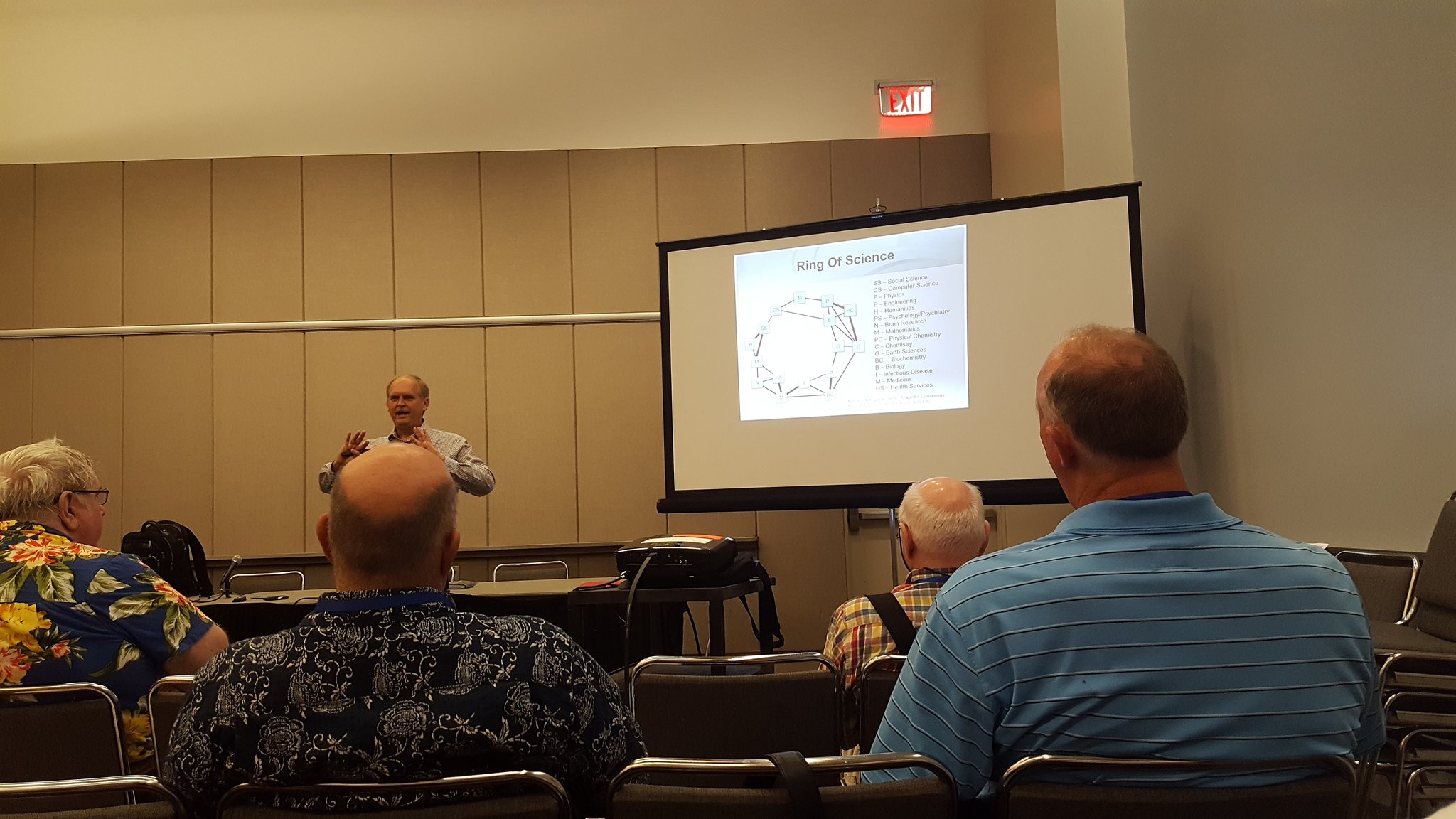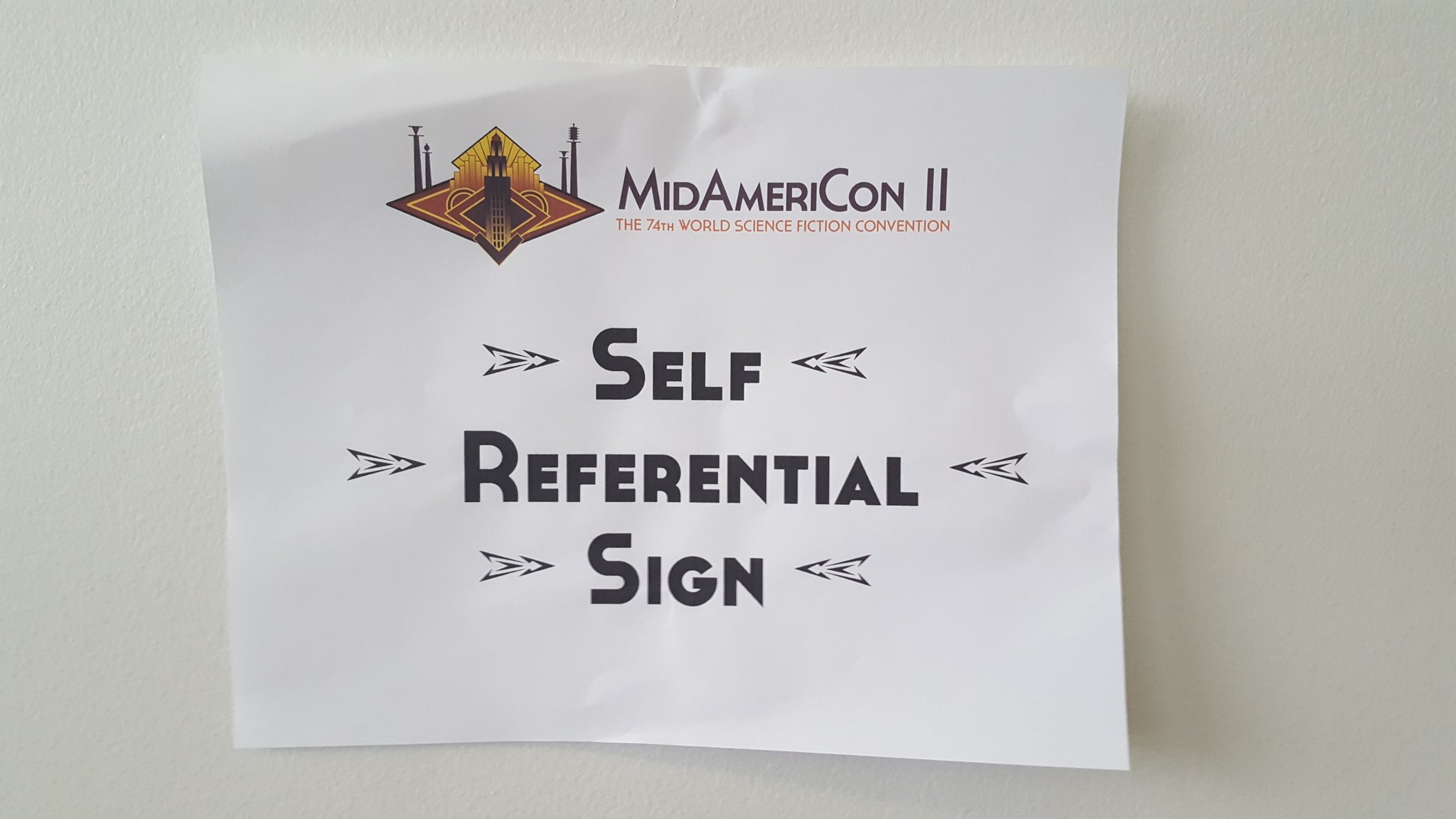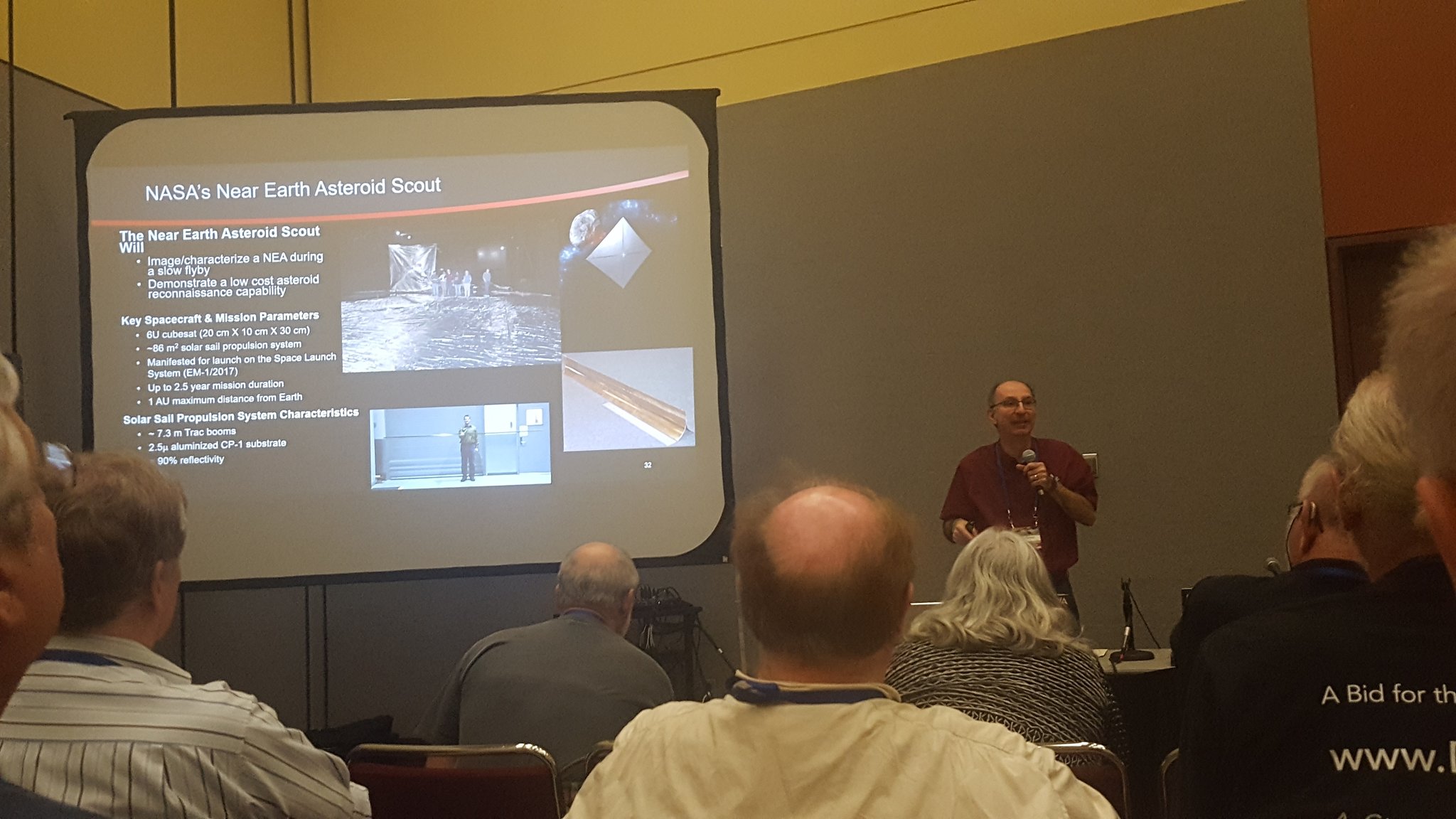Please understand that my memory is not perfect, and that my summaries may misstate or misconstrue the views of the speakers. These should also not be taken as complete synopses of the talks given. I take notes mainly for my own use, and what is included reflects this fact. You can find a full listing of programming here.
Day One.
The first talk I attended was When Robots Rule the Earth by Robin Hanson. Essentially, he hit the major points behind his book Age of Em. I could do an entire post on that talk alone, but let me discuss a few of them.
First is the rate of economic growth. On a logarithmic scale, human history can be described by punctuated equilibrium of productivity--a series of plateaus, with sharp jumps in between them. The duration of these plateaus is also a trend, which is where he gets the 1-2 year estimate for how long the next period will last.
Hanson is describing one possible scenario with his notion of brain emulation. Many others are possible. He estimates that the age of em has greater than 1% chance of being what happens.
Without having read the book, I don't know what he covers and what is novel to readers. A few things stuck out to me, though. One was the notion that as our wealth increases, our lifestyle becomes more like that of hunter-gatherer societies (high recreation, more flexibility, etc). Emulation society, since it would likely be hypercompetitive, might end up more like the farmer-herder cultures in terms of restricting values. A consequence of this would be higher religiosity in ems than humans.
Additionally, em society would be more stratified than ours, though likely by simulation speed as opposed to productivity (Hanson hypothesizes that only the very best humans would be emulated). Simulation speed would impose a constraint on communication distance. Human brains run far slower than the theoretical limit for transmissions around the world. Minds running thousands of times faster would not have that luxury. Note that ems would not be interested in space travel for this reason (and because their entire era might end by the time a Mars mission could be completed).
 |
| Dr. Hanson during his talk. |
After that I went in for something a little lighter:
New Trends in Young Adult Novels. The resounding conclusion from the panelists was that trying to follow trends is probably not the best idea, because the time between beginning and publishing a book is too long (which is why we see so much trash after a good series kicks off a fad). A better approach is to write drafts and dust them off when a new trend begins.
In the longer term, young adult books have mostly been written in first person, and increasingly the present tense. Middle grade books are still frequently in third person, and more likely to be past tense. First person aids in immersion, but isn't a strict requirement.
That said, a few things are known. Romance is overdone. Dystopia is going out, if you've written one try branding it as science fiction. Horror is in right now. Multicultural stories are finally getting the sort of attention they deserve.
Oh, and reviews matter more than most readers think.
Science Fiction as Epic was largely forgettable, though the concert on the other side of the wall didn't help any. I don't feel like I learned very much from this one. Epics can be considered to run to things out to the very edge of their world, with larger-than-life characters and a large canvas. In science fiction this is often embodied by the genius scientist or daring astronaut types. Humor is a dangerous element, as it can undercut the melodrama. Economic considerations are rarely looked at. Does an epic require
adventure? We don't get a definitive answer.
The next talk asked whether
Heinlein Juveniles Stand Up. I'm pretty sure I was the youngest person in the room for that, but the panelists report that by-and-large they do, though perhaps not for the reasons one'd expect. It isn't unrealistic spaceships that throw off contemporary readers--it's the slang. That never bothered me, because what modern slang I picked up left a bad taste in my mouth, but am I a typical youth? Hardly.
Part of Heinlein's appeal is his refusal to talk down to young readers. He saturates his stories with technical details and moral messages, because they're sincere and practical. A big part of his juveniles deal with the training of the protagonists, usually not in traditional schools. The actual plot is frequently formulaic (or is that just hindsight bias?).
Several commentators said that they feels his juveniles read like the first half of his later works, which feature a lot more introspection about the world characters find themselves in.
Heinlein juveniles usually feature competent mentor figures, teaching the protagonists about citizenship, responsibility, and ethics. His characters are not "the chosen one". They either earn their place, or are randomly entrapped in their adventures.
He frequently focused on male readers, possibly because the science fiction fan gender balance was worse back then, and also because that what the marketers
thought would sell. His long-running adversarial relationship with the editor was largely over what he wanted to write, versus what would actually get bought and put in libraries. After
Starship Troopers was rejected, he gave up on writing books for kids.
Some of these books are currently being adapted to graphic novel form by the estate.
100 Years of Continental Drift was a big heavier. I learned that the first recognition of similar coastlines was in the 1600s, but no progress was made before Wegener formulated continental drift. His theory was rejected for multiple reasons. One was outsider bias: he was a German climatologist trying to tell American geologists how to do their jobs. Another was that his mechanism proved factually wrong. Continents don't cut through oceanic crust, driven by Earth's rotation--continents would accumulate on the equator, and basaltic crust is far more dense than the granite of land. Think of butter cutting a knife.
Plate tectonics proposes a more plausible mechanism--convention currents in the mantle--and benefits from more modern evidence. After World War II a scientist used Navy data to argue a ridge existed in the Mid-Atlantic. Her absurd claims were proven wrong when they sent down a submarine and there the ridge was. More interestingly, there's symmetric signatures of Earth's magnetic reversals in the rock on each side of the mountains, suggesting sea-floor spreading.
Another interesting piece of trivia is that Olympus Mons is so big because Mars didn't have enough heat to drive plates around. Olympus Mons formed from a mantle plume, but never moved. Imagine how big Mauna Loa would be if all the Hawaiian Islands were pooled into that one mountain. Internal planet heat is ruled by an inverse square law.
Earth is expanding by about 0.0001% per year, but that's far to low to justify claims of Earth Expansion Theory, which is popular among certain Creationist sorts.
Something I probably once knew but forgot: most of our knowledge of Earth's interior comes from nuclear tests, which produce large vibrations which can be detected on the other side of the planet.
Dad went to the talk on
Heinlein Predictions, and I took notes for him on
Middle Grade versus Young Adult Fiction. The answer is that it's largely subjective. Keep in mind that kids usually read up--just because your protagonist is 15 doesn't mean your target audience is.
They might also be older, since adults with disposable income read a lot of YA. For one thing, YA is easy reading for fully-formed minds. Another reason is because it deals with early life experiences, which are much more intense the first time around. A good book can evoke a lot of emotion in adults thrice the target audience's age.
Getting into the content distinctions, MG deals with a lot of kids with power in their world. Think "adventure with fun and friends". YA deals with the reality of continued helplessness and the problems that teenagers experience: school, relationships, and life choices.
The panelists emphasized that children today live very different lives than the adult authors writing for them. They know a lot more than you think they know, but are also held inside by the modern scaremongering. Books are their playground. This can be both good and bad. Books let them into worlds they couldn't experience themselves, but can also warps their perception of normal. YA relationships are generally not healthy, and when read by impressionable readers.....
On a technical note, length isn't a huge factor in the post-Harry Potter era. Don't write
War and Peace unless you have a trilogy deal, but don't worry about 100,000 words.
The final talk we attended before heading home was on
Creating Worlds in Fantasy, Science Fiction, and Horror. There's different approaches to this. Do you build the world first and then insert the story? Do you begin with a character and then construct the world around them? You may not have the time or desire to figure out all the details. This isn't a bad thing. Mystery is often more satisfying than half-assed answers (for instance, midi-chlorians).
Handwaving applies to societies just as much as technology. If the story is good enough, it won't particularly matter. Alien worlds may require a ton of research to make plausible. If you're relying on adjectives to get the emotional response you want, you've failed at your job.
Character-driven fantasy is hard--many choose to focus on the relation between the character and their world.
Pay attention to your own rules. Understand the world you're writing. Many stories that used to work don't work anymore because everyone has cell phones. Deal with consequences realistically. This especially shows up with major character deaths. Don't make your characters invincible and certain of victory if you want your reader to be engaged. There has to be an emotional stake, but it's too easy to introduce characters just to kill them off. Family costs are overdone.
Timing is important in exposition. So is relevance. You don't need to frontload the exposition, but also don't interrupt action scenes to give us details. Infodumping and character interaction are okay. Don't feel the need to do everything in dialog--it leads to unnatural conversations. Reading aloud can help.
For another Star Wars example, prequels usually fail because the relevant information has already been delivered. Discerning viewers can pick up all the major events from dialog in the original trilogy.
That's it for day two. I would have liked to have stayed for the panel on locked planets, but it was late in the evening and I need to turn in.






